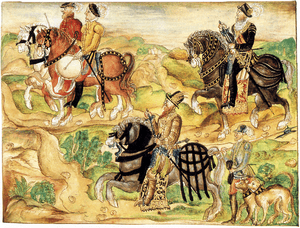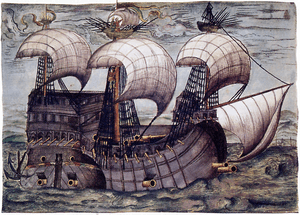Klein-Venedig facts for kids
Quick facts for kids
Little Venice
Klein-Venedig
|
|||||||||
|---|---|---|---|---|---|---|---|---|---|
| 1528–1546 | |||||||||

Location of Klein-Venedig, hard purple: full controlled area by the House of Welser, light purple: allowed expeditions by the Spanish Empire
|
|||||||||
| Status | Colony of the Free Imperial Cities of Augsburg and Nuremberg | ||||||||
| Capital | Neu-Augsburg | ||||||||
| Common languages | German | ||||||||
| Religion | Roman Catholicism, Lutheranism | ||||||||
| History | |||||||||
|
• Established
|
1528 | ||||||||
|
• Disestablished
|
1546 | ||||||||
|
|||||||||
| Today part of | Venezuela Colombia |
||||||||
Klein-Venedig (meaning "Little Venice") or Welserland was a German colony in South America from 1528 to 1546. It was located in what is now Venezuela. The Welser family, a rich banking family from the German cities of Augsburg and Nuremberg, gained control of this land.
They got these rights from Emperor Charles V, who was the Holy Roman Emperor and also King of Spain. He owed the Welser family a lot of money. In 1528, Charles V gave the Welsers permission to explore, rule, and colonize the area. One main goal was to find the legendary golden city of El Dorado.
The first leader of the colony was Ambrosius Ehinger, who founded the city of Maracaibo in 1529. After Ehinger died in 1533, Georg von Speyer took over. When Speyer died in 1540, Philipp von Hutten continued the explorations. While Hutten was away, the King of Spain decided to appoint his own governor. When Hutten returned in 1546, the Spanish governor, Juan de Carvajal, had Hutten and Bartholomeus VI. Welser killed. Soon after, Emperor Charles V took back the Welsers' rights to the colony.
The Welser family brought German miners and many people to work on sugar cane plantations. Many German colonists died from tropical diseases or were attacked by local native groups during their search for gold.
Contents
Why was Klein-Venedig created?
Bartholomeus V. Welser was the head of the Welser banking family. They were very wealthy and lent large sums of money to Emperor Charles V. To pay back these debts, the Emperor, who was also King of Spain, gave the Welser family control of the newly discovered Province of Venezuela in 1527.
The Welser family had to conquer the land themselves. They also had to use Spanish and Flemish soldiers, send out two groups of ships, and build two cities and three forts within two years. Since people believed Venezuela had gold mines, the Welsers later got permission to send 150 German miners there.
The Search for El Dorado
Many explorers during this time were looking for a legendary city of gold called El Dorado. The Welsers were also hoping to find it.
Ambrosius Ehinger's Expeditions

In 1528, the Welser family sent a fleet of ships from Spain, led by Ambrosius Ehinger. He was appointed the main leader, or captain general. Ehinger arrived in Santa Ana de Coro (which they called Neu-Augsburg), the capital of the Province of Venezuela, on February 24, 1529.
From Coro, Ehinger explored the land, hoping to find El Dorado. In August 1529, he went to Lake Maracaibo. The local Coquivacoa people fought fiercely against them. After several battles, Ehinger founded the settlement of Maracaibo on September 8, 1529. He first named it New Nuremberg (German: Neu-Nürnberg). The lake was named after a brave Coquivacoa leader named Mara, who died in the fighting. Later, the Spanish renamed the city Maracaibo.
Ehinger became sick with malaria and went to Hispaniola to recover. He left Nicolaus Federmann in charge. When Ehinger returned, he started a second expedition on September 1, 1531, with 40 horses and 130 soldiers, plus many allied native people. They searched for gold country to the west.
During this journey, they faced many challenges. They had to eat their horses and dogs, and many of their native allies died from the cold in the mountains. On May 27, 1533, they were attacked by the Chitareros. Ehinger was hit by a poisoned arrow in the neck and died on May 31, 1533. The expedition returned to Coro without him.
Later Governors and Explorers
After Ehinger's death, Georg von Speyer became the governor of Venezuela in 1534. He arrived in Coro on February 22, 1534.

Between 1535 and 1538, Speyer searched for El Dorado in southwestern Venezuela and northern Colombia. He was joined by Nikolaus Federmann and later Philipp von Hutten. Speyer and Federmann started with 450 soldiers and 1,500 friendly native people. They followed a salt trade route through the Andes mountains.
After traveling together for about 200 miles, Speyer and Federmann split up, planning to meet later. Speyer's group faced many difficulties, including attacks from hostile native groups and soldiers who rebelled. When they reached the meeting point, Federmann was not there. Federmann had crossed the Andes to Bogotá, where he met other Spanish explorers.
Speyer continued his search for El Dorado, but heavy rains and flooded rivers made progress difficult. Many of his men became sick and died. In early 1539, he returned to Coro with only 80 sick and tired men out of the many he had started with. He had not found any gold.
Because of poor health, von Speyer resigned as governor in 1539 and died in June 1540.
In December 1540, Philipp von Hutten became the new governor of Venezuela. Hutten continued the search for El Dorado deep in the interior. After several years of traveling, facing hunger, sickness, and attacks from native groups, he and his followers found a large city, the capital of the Omaguas people. However, they were defeated by the native people, and Hutten was badly wounded.
Hutten led the survivors back to Coro in 1546. There, he found that a Spaniard named Juan de Carvajal had been appointed by the Spanish authorities to keep order in Venezuela. Carvajal had founded a new town called El Tocuyo and felt secure in his position. He was not happy to see the German adventurers return.
Carvajal tried to make Hutten and his men accept his authority. When this failed, he tried to capture them. Hutten's companion, Bartholomeus VI. Welser, wounded Carvajal. Carvajal then promised the Germans safe passage to Coro. However, during their journey, Carvajal captured Hutten and Welser in April 1546. After keeping them in chains for a while, he had them beheaded.
A few years later, in 1556, Emperor Charles V gave up his throne. This officially ended the Welser family's attempts to regain control of their colony.
Who Governed Klein-Venedig?
Here is a list of the main leaders of Klein-Venedig:
| Image | Name | Term | Notes |
|---|---|---|---|
 |
Ambrose von Ehinger | 1529–1530 | Known in Spanish as Ambrosio Alfinger |
| Georg von Ehinger | 1530 | Tried to take control but was stopped | |
| Hans Seissenhofer von Key | 1530 | An acting leader | |
| Bartholomeus Sayler | 1531–1533 | Known in Spanish as Bartolomé de Santillana | |
 |
Ambrose von Ehinger | 1533 | Returned for a second term |
 |
Nicolas Federmann | 1533–1535 | Served as a temporary leader after Ehinger's death |
| Georg Hohermut von Speyer | 1535–1540 | Known in Spanish as Jorge de Espira | |
| Heinrich Remboldt | 1540–1543 | A mayor and acting governor. He ordered the founding of Barquisimeto | |
 |
Philipp von Hutten | 1543–1544 | Known in Spanish as Felipe de Utre |
| Melchior Grübel | 1557–? | Acting mayor of El Tocuyo and Neu-Augsburg |
See also
 In Spanish: Klein-Venedig para niños
In Spanish: Klein-Venedig para niños
- German colonial projects before 1871
- List of former German colonies
Images for kids





